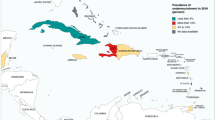Abstract
This paper aims to contribute to the urban food security debate by exploring the role of informal safety nets and formal food-based social protection in addressing food insecurity challenges facing low-income urban households in Manzini. The empirical data used in this paper came from two surveys: the first involved 500 households and was undertaken in three low-income areas of Manzini. The second involved a series of in-depth interviews with senior staff at supermarkets and spaza shops. The results reveal that food security challenges are considerable in the low-income areas of Manzini and that, at the same time, various forms of community and intra-household food sharing are an important food source for a minority of poor households in the city. In this regard, the national government needs to consider strengthening food-based social safety net programmes that assist poor and vulnerable groups.


Similar content being viewed by others
References
AMICAALL (2012). Monthly social centre status report—October 2012. Manzini.
Crush, J., Hovorka, A., & Tevera, D. (2011). Food security in Southern African cities: the place of urban agriculture. Progress in Development Studies, 11(4), 285–305.
CSO. (2007). Swaziland demographic and health survey 2006–07. Mbabane: Central Statistical Office.
DPMO. (2011). Annual performance report. Mbabane: Deputy Prime Minister’s Office.
Edje, O. (2010). Drought and food security in Swaziland. In D. Tevera & J. Matondo (Eds.), Socio-economic development and the environment in Swaziland (pp. 130–151). Kwaluseni: GEP.
Government of Swaziland. (2005). National food security policy for Swaziland. Mbabane: Ministry of Agriculture and Co-operatives.
Government of Swaziland (2008). Swaziland: annual vulnerability assessment and analysis report. Mbabane.
HLPE. (2012). Social protection for food security. Report by the High Level Panel of Experts on Food Security and Nutrition. Rome: Committee on World Food Security.
Mabuza, M., Hendriks, S., Ortmann, G., & Sithole, M. (2009). The impact of food aid on maize prices and production in Swaziland. Agrekon, 48(1), 85–105.
Masuku, M., & Sithole, M. (2009). The impact of HIV/AIDS on food security and household vulnerability in Swaziland. Agrekon, 48(2), 200–222.
NERCHA. (2012). Mapping of neighbourhood care points 2010/2011. Mbabane: NERCHA.
Oseni, T., & Masarirambi, M. (2011). Effect of climate change on maize (Zea mays) production and food security in Swaziland. American-Eurasian Journal of Agricultural and Environmental Science, 11(3), 385–391.
RHVP (2007a). Neighbourhood care points for OVC, Swaziland. REBA Case Study Brief No. 14.
RHVP (2007b). Old age and public assistance grants, Swaziland. REBA Case Study Brief No. 6.
Sihlongonyane, M. (2003). Local economic development in Swaziland: the case of Manzini City. Urban Forum, 14(2–3), 244–263.
Swazi VAC, & UNWFP. (2008). Vulnerability and food insecurity in urban areas of Swaziland: an assessment of the impact of high prices on households in four regions. Mbabane: Swaziland Vulnerability Assessment Committee and UN World Food Programme.
Terry, A., & Ryder, M. (2009). Improving food security in Swaziland: the transition from subsistence to communally managed cash cropping. Natural Resources Forum, 31(4), 263–272.
Tevera, D. (2011). Migration and development in Swaziland. UNISWA Research Journal, 26, 15–27.
Tevera, D., & Matondo, J. (Eds.). (2010). Socio-economic development and the environment in Swaziland. Kwaluseni: GEP.
Tevera, D., & Zamberia, A. (2010). Urbanization and urban management in Swaziland. In D. Tevera & J. Matondo (Eds.), Socio-economic development and the environment in Swaziland (pp. 272–288). Kwaluseni: GEP.
Tevera, D., Simelane, N., Peter, G. & Salam, A. (2012). The state of food insecurity in Manzini, Swaziland. AFSUN Urban Food Security Series No. 15, Cape Town.
UNICEF. (2006). Report on the assessment of neighbourhood care points: Swaziland—2006. Mbabane: UNICEF.
World Food Programme (2006). Global school feeding report 2006. Rome: WFP School Feeding Service.
Acknowledgments
We wish to thank the Canadian Government for funding the AFSUN baseline survey in Manzini.
Author information
Authors and Affiliations
Corresponding author
Rights and permissions
About this article
Cite this article
Tevera, D., Simelane, N. Food for the Urban Poor: Safety Nets and Food-Based Social Protection in Manzini, Swaziland. Urban Forum 25, 241–252 (2014). https://doi.org/10.1007/s12132-014-9226-4
Published:
Issue Date:
DOI: https://doi.org/10.1007/s12132-014-9226-4




